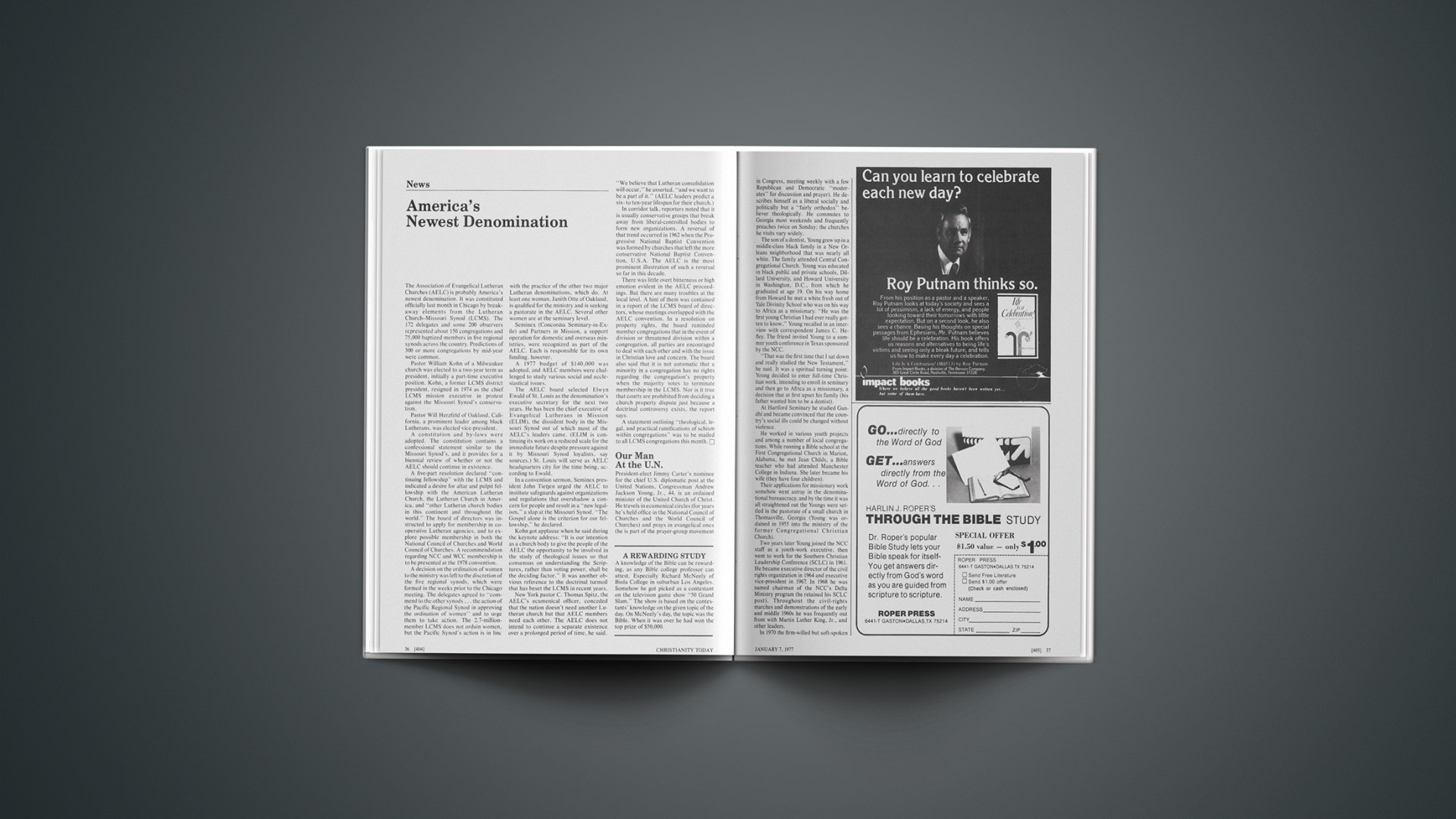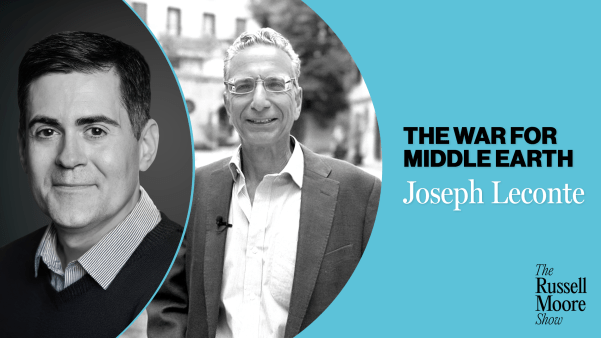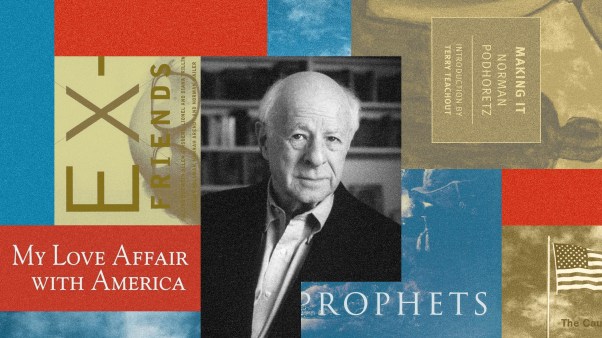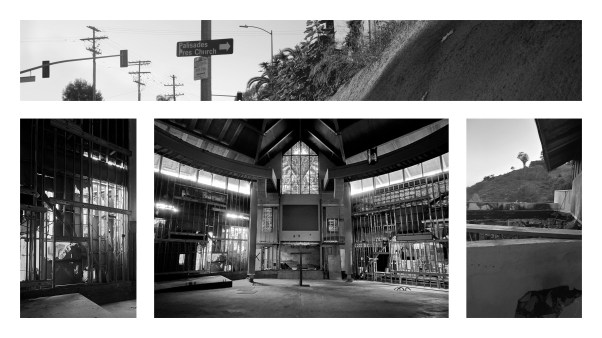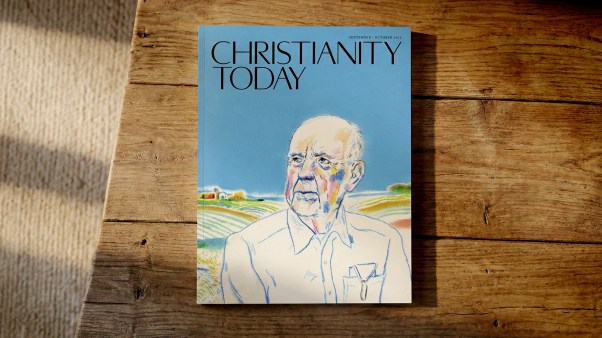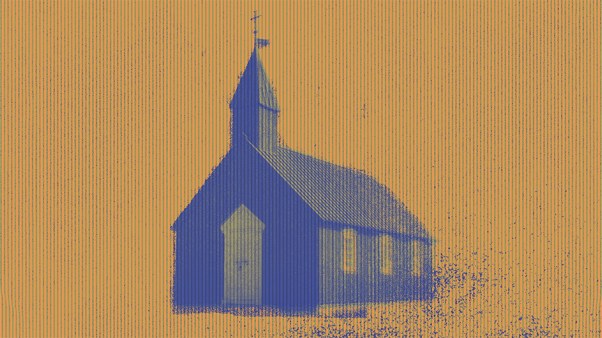The Association of Evangelical Lutheran Churches (AELC) is probably America’s newest denomination. It was constituted officially last month in Chicago by break-away elements from the Lutheran Church-Missouri Synod (LCMS). The 172 delegates and some 200 observers represented about 150 congregations and 75,000 baptized members in five regional synods across the country. Predictions of 300 or more congregations by mid-year were common.
Pastor William Kohn of a Milwaukee church was elected to a two-year term as president, initially a part-time executive position. Kohn, a former LCMS district president, resigned in 1974 as the chief LCMS mission executive in protest against the Missouri Synod’s conservatism.
Pastor Will Herzfeld of Oakland, California, a prominent leader among black Lutherans, was elected vice-president.
A constitution and by-laws were adopted. The constitution contains a confessional statement similar to the Missouri Synod’s, and it provides for a biennial review of whether or not the AELC should continue in existence.
A five-part resolution declared “continuing fellowship” with the LCMS and indicated a desire for altar and pulpit fellowship with the American Lutheran Church, the Lutheran Church in America, and “other Lutheran church bodies in this continent and throughout the world.” The board of directors was instructed to apply for membership in cooperative Lutheran agencies, and to explore possible membership in both the National Council of Churches and World Council of Churches. A recommendation regarding NCC and WCC membership is to be presented at the 1978 convention.
A decision on the ordination of women to the ministry was left to the discretion of the five regional synods, which were formed in the weeks prior to the Chicago meeting. The delegates agreed to “commend to the other synods … the action of the Pacific Regional Synod in approving the ordination of women” and to urge them to take action. The 2.7-million-member LCMS does not ordain women, but the Pacific Synod’s action is in line with the practice of the other two major Lutheran denominations, which do. At least one woman, Janith Otte of Oakland, is qualified for the ministry and is seeking a pastorate in the AELC. Several other women are at the seminary level.
Seminex (Concordia Seminary-in-Exile) and Partners in Mission, a support operation for domestic and overseas ministries, were recognized as part of the AELC. Each is responsible for its own funding, however.
A 1977 budget of $140,000 was adopted, and AELC members were challenged to study various social and ecclesiastical issues.
The AELC board selected Elwyn Ewald of St. Louis as the denomination’s executive secretary for the next two years. He has been the chief executive of Evangelical Lutherans in Mission (ELIM), the dissident body in the Missouri Synod out of which most of the AELC’s leaders came. (ELIM is continuing its work on a reduced scale for the immediate future despite pressure against it by Missouri Synod loyalists, say sources.) St. Louis will serve as AELC headquarters city for the time being, according to Ewald.
In a convention sermon, Seminex president John Tietjen urged the AELC to institute safeguards against organizations and regulations that overshadow a concern for people and result in a “new legalism,” a slap at the Missouri Synod. “The Gospel alone is the criterion for our fellowship,” he declared.
Kohn got applause when he said during the keynote address: “It is our intention as a church body to give the people of the AELC the opportunity to be involved in the study of theological issues so that consensus on understanding the Scriptures, rather than voting power, shall be the deciding factor.” It was another obvious reference to the doctrinal turmoil that has beset the LCMS in recent years.
New York pastor C. Thomas Spitz, the AELC’s ecumenical officer, conceded that the nation doesn’t need another Lutheran church but that AELC members need each other. The AELC does not intend to continue a separate existence over a prolonged period of time, he said.
“We believe that Lutheran consolidation will occur,” he asserted, “and we want to be a part of it.” (AELC leaders predict a six-to ten-year lifespan for their church.)
In corridor talk, reporters noted that it is usually conservative groups that break away from liberal-controlled bodies to form new organizations. A reversal of that trend occurred in 1962 when the Progressive National Baptist Convention was formed by churches that left the more conservative National Baptist Convention, U.S.A. The AELC is the most prominent illustration of such a reversal so far in this decade.
There was little overt bitterness or high emotion evident in the AELC proceedings. But there are many troubles at the local level. A hint of them was contained in a report of the LCMS board of directors, whose meetings overlapped with the AELC convention. In a resolution on property rights, the board reminded member congregations that in the event of division or threatened division within a congregation, all parties are encouraged to deal with each other and with the issue in Christian love and concern. The board also said that it is not automatic that a minority in a congregation has no rights regarding the congregation’s property when the majority votes to terminate membership in the LCMS. Nor is it true that courts are prohibited from deciding a church property dispute just because a doctrinal controversy exists, the report says.
A statement outlining “theological, legal, and practical ramifications of schism within congregations” was to be mailed to all LCMS congregations this month.
A Rewarding Study
A knowledge of the Bible can be rewarding, as any Bible college professor can attest. Especially Richard McNeely of Biola College in suburban Los Angeles. Somehow he got picked as a contestant on the television game show “50 Grand Slam.” The show is based on the contestants’ knowledge on the given topic of the day. On McNeely’s day, the topic was the Bible. When it was over he had won the top prize of $50,000.
Our Man At the U.N.
President-elect Jimmy Carter’s nominee for the chief U.S. diplomatic post at the United Nations, Congressman Andrew Jackson Young, Jr., 44, is an ordained minister of the United Church of Christ. He travels in ecumenical circles (for years he’s held office in the National Council of Churches and the World Council of Churches) and prays in evangelical ones (he is part of the prayer-group movement in Congress, meeting weekly with a few Republican and Democratic “moderates” for discussion and prayer). He describes himself as a liberal socially and politically but a “fairly orthodox” believer theologically. He commutes to Georgia most weekends and frequently preaches twice on Sunday; the churches he visits vary widely.
The son of a dentist, Young grew up in a middle-class black family in a New Orleans neighborhood that was nearly all white. The family attended Central Congregational Church. Young was educated in black public and private schools, Dillard University, and Howard University in Washington, D.C., from which he graduated at age 19. On his way home from Howard he met a white fresh out of Yale Divinity School who was on his way to Africa as a missionary. “He was the first young Christian I had ever really gotten to know,” Young recalled in an interview with correspondent James C. Hefley. The friend invited Young to a summer youth conference in Texas sponsored by the NCC.
“That was the first time that I sat down and really studied the New Testament,” he said. It was a spiritual turning point. Young decided to enter full-time Christian work, intending to enroll in seminary and then go to Africa as a missionary, a decision that at first upset his family (his father wanted him to be a dentist).
At Hartford Seminary he studied Gandhi and became convinced that the country’s social ills could be changed without violence.
He worked in various youth projects and among a number of local congregations. While running a Bible school at the First Congregational Church in Marion, Alabama, he met Jean Childs, a Bible teacher who had attended Manchester College in Indiana. She later became his wife (they have four children).
Their applications for missionary work somehow went astray in the denominational bureaucracy, and by the time it was all straightened out the Youngs were settled in the pastorate of a small church in Thomasville, Georgia (Young was ordained in 1955 into the ministry of the former Congregational Christian Church).
Two years later Young joined the NCC staff as a youth-work executive, then went to work for the Southern Christian Leadership Conference (SCLC) in 1961. He became executive director of the civil rights organization in 1964 and executive vice-president in 1967. In 1968 he was named chairman of the NCC’s Delta Ministry program (he retained his SCLC post). Throughout the civil-rights marches and demonstrations of the early and middle 1960s he was frequently out front with Martin Luther King, Jr., and other leaders.
In 1970 the firm-willed but soft-spoken Young won the Democratic nomination for Congress from Georgia’s fifth district but lost the election. In 1972 he ran again and became Georgia’s first black congressman since 1870. During these forays he often bumped into a rising Georgia politician named Jimmy Carter (he ran for governor in 1970). “I found out he was sensitive to people,” says Young, “and that impressed me.” They became friends. During the recent presidential campaign, Young was one of Carter’s closest advisors, and he helped to deliver the black vote.
Young is on the international committee that oversees the WCC’s controversial Program to Combat Racism. He says he is committed to the concept of majority rule in southern Africa. Therefore, he had no problems of conscience as a committee member in approving grants to “liberation” movements. “The money was to be used for humanitarian purposes—food, clothing, medical care,” he says. “We made no judgment on the way in which the people struggled against oppression.”
The Youngs envision themselves someday going back to a little country church “to work with ordinary people and their problems.” But for now it’s a big building in New York and some very big problems as America’s ambassador to the United Nations.
“I hope that I will always be open enough for God to lead me, no matter where it is that he wants me to go,” affirms the minister.
EDWARD E. PLOWMAN
Amy’s New Teacher
The wife of a United Methodist pastor will be Amy Carter’s new teacher when the daughter of the President-elect moves to Washington.
“We have a lot in common, being from the South and, most important of all, Christian,” said Mrs. Verona Meeder, fourth- and fifth-grade teacher at Thaddeus Stevens School, located about five blocks from the White House.
Mrs. Meeder, a black, is a native of North Carolina. Her husband was the pastor of a United Methodist church near the school until last June. Since then, Andrew Meeder has been the pastor of Lanham Methodist Church in suburban Maryland. He is a graduate of Garrett Theological Seminary in Evanston, Illinois. The couple met while both were students at East Carolina University.
The Thaddeus Stevens School is located just off K Street Northwest, a key thoroughfare along which a number of the capital’s modern commercial office buildings are situated. The 108-year-old school was originally built for black children and was segregated during its first eighty-six years.
Nine-year-old Amy, whose mother was reared a Methodist, will be the first child of an American president to attend public school in Washington since Theodore Roosevelt’s son Quentin. The three-story school has 215 pupils from pre-kindergarten through the sixth grade. About 60 per cent are black American (more than 90 per cent of Washington’s public-school population is black), 10 per cent are white American, and the remaining 30 per cent are foreign-born from some two dozen countries, most of them from the diplomatic community.
Mrs. Meeder has taught at the school for ten years. Some of her pupils are Hindu and Muslim. They are excused from classes on their religious holidays.
John Novotney, Religious News Service correspondent, quoted the teacher as saying: “I consider it quite a responsibility. I feel a sense of mission to be given the challenge to teach her, and I’m very serious about how to deal with it.” She added that she hoped that as a result the image of urban schools will be given a lift.
As a pastor’s wife, Mrs. Meeder has taught Sunday school and worked with church women’s groups over the years. The Meeders have three children, a 21-year-old girl who is finishing college and two teen-age boys.
Amy’s new school, named after a Republican abolitionist congressman of the Civil War era, has reportedly been besieged with requests from parents in the suburbs offering to pay high tuition rates to be able to transfer their children there.
Secret Service spokesmen will not say how they intend to handle Amy’s security while she is at school, but if it becomes difficult she may be transferred to a more secluded private institution.
War in Toronto
In a move that made front-page news in the city’s papers and dominated newscasts early last month, Roman Catholic archbishop Philip Pocock of Toronto launched a full-scale attack on pornography. The spiritual head of Canada’s largest English-speaking archdiocese called on the 900,000 faithful to boycott all publications, theaters, and businesses that “encourage the pornographic.”
He issued his call to arms in advertisements in all three Toronto dailies. They were paid for by the Knights of Columbus. In the ads, Pocock said the prime motivation for the current “amazing proliferation” of pornographic material is financial profit, but the ultimate result is “the destruction of the moral fibre and virtue of our people, especially the young.”
Priests in the 200 congregations of the archdiocese were ordered to read the letter at masses and to preach against pornography. Parents were urged to protest the sale of smut at neighborhood stores and to ask that “adult” publications, if they must be carried, be kept out of sight.
In an unprecedented display of unanimity, major Protestant leaders voiced their support and urged their church members to support the anti-obscenity drive.
LESLIE K. TARR
Saints in Memphis
Bishop J. O. Patterson, Sr., 64, was elected to a third four-year term as international presiding bishop of the three-million-member Church of God in Christ. The action was taken at the recent annual Holy Convocation of the black Pentecostal denomination in Memphis. Plans were also approved to build a $20 million national headquarters to be known as “Saints Center” in downtown Memphis. The complex will contain a 15,000-seat-dome-shaped auditorium, a 2.000-car garage, and other church facilities.
An estimated 45,000 delegates attended one or more sessions of the convention, which combined around-the-clock revival services and business meetings.
Serving Under Fire
The tightrope that relief administrators must walk to serve war victims was spotlighted by the National Catholic Reporter last month. The independent, lay-edited Catholic weekly, in a major feature article, warmed over allegations that it began making about ten years ago. It charged that officials of Catholic Relief Services (CRS) in Viet Nam were too cozy with government people. In particular, said the paper, the CRS director from 1967, Robert L. Charlebois, was too close to the Central Intelligence Agency and American Army personnel.
Charlebois, now working in CRS headquarters, was quick to deny that he had worked hand-in-glove with the U.S. military. His job, he said, was to “feed the poor.” The new CRS executive director, Bishop Edwin Broderick, said CRS’s goal for twenty-one years in Southeast Asia was “to help as many of God’s poor as possible.” In order to accomplish this, he explained, “it was necessary for CRS to work cooperatively with whatever governments were involved. Without their logistical support, it would be utterly impossible for CRS to carry on any kind of effective relief program.” Broderick stressed, however, that “at no time did CRS knowingly act on behalf of any military intelligence agencies, and if CRS reports and correspondence were used to supply any organization with ‘intelligence’ information, then CRS was never aware of such procedures.”
The Reporter feature, written by the weekly’s Washington correspondent, Richard Rashke, included some previously unpublished allegations by former CRS workers. It was entitled, “Christ’s Work—or the CIA’s.” While some of the material vital to the article’s overall charges is not attributed to any source, most of the new material is linked to Jacqui Chagnon, a former CRS staffer in Vietnam now working in Washington for Clergy and Laity Concerned, an anti-war group. Also quoted is Heinz Kotte, an expriest now working in Germany with Action for a World in Solidarity. Both claimed that goods were provided directly to the military or to families of soldiers. In response, CRS officials said the quickest and fastest way to get commodities to the needy was through the military.
Rashke’s article charged that U.S. personnel in charge of the war effort used a “carrot and stick” technique to get CRS workers to cooperate. Those who provided intelligence information and who were otherwise cooperative got such help as postal and post-exchange privileges, priority travel on CIA and military flights, and free housing, the article said. Charlebois responded that instead of being given such privileges, he often fought for them.
The article noted the resignation of a number of staffers who were disgusted with the relations between CRS and government officials. Charlebois said his people “were told before they came to Viet Nam that we were apolitical.… There were times when people got so emotionally involved that they couldn’t perform, at which time they had to be relieved from the staff.… I can honestly say I never, ever, removed a staff person at a request or suggestion of U.S. or Vietnamese officials.”
CRS is the largest relief agency in the world. The outlay in the past year, according to Associated Press figures, was $257 million, and in the past thirty-three years it has amounted to $3.7 billion.
High Tension In Latin America
Tension continues between the government of Ecuador and the Roman Catholic Church following the arrest of thirty-one people in a church-owned retreat house north of Quito in late November. The group was described by the minister of government, Colonel Bolivar Jarrin, as subversive and “ready to begin guerrilla activity.” Jarrin charged there were direct links between the group and the bishops’ meeting in the city of Riobamba in August that was broken up by police and resulted in the expulsion of a number of foreign clergy from the country (see September 10, 1976, issue, page 68).
A Spanish priest and two Ecuadorian ex-priests were among those detained, along with officials of the Catholic University, according to reports. The Spaniard was later expelled.
Among other accusations, the government claimed the group planned to incite the peasants. A number of farms in the province of Chimborazo have been occupied in recent weeks by peasants demanding land. They have the backing of Bishop Leonidas Proana of Riobamba, capital of the province, who organized the August bishops’ meeting.
The military government said that it is determined to continue with its plan for a return to democracy, with elections scheduled this year, but that it can do so only “in a climate of order and peace.”
According to a document found by police, the group arrested was allegedly planning to found a clandestine political movement, the “National Democratic Union,” which was to be formed by “the democratic elements of the people, the armed forces, and the new church.”
Meanwhile, in Colombia, the Catholic hierarchy there warned in a document released November 30 that Marxism is penetrating the church. The document, signed by sixty-five leaders from all over the country, criticized in harsh terms various dissident movements of priests and liberationist thinking, which “puts the temporal above the spiritual and tends to negate the transcendence of Christ’s redemptive action.”
The declaration was released three weeks after the military arrested three priests and a nun in Cartagena and confiscated arms, military uniforms, medicines, and cash that were hidden in a church and in the priests’ homes, apparently destined for the Communist guerrilla “National Liberation Army” (ELN). The four were accused of serving as a link with the guerrillas.
The bishops’ declaration characterized the Marxist influence as “not simply a compromising action in the light of the requirements of social justice” but “an attack against the pillars of the Catholic faith itself.”
STEPHEN R. SYWULKA
No Obituary Yet For Church Colleges
Church-related colleges, especially those with strong evangelical commitments, are not necessarily an endangered species. This finding, contrary to widely held opinion, was reported at year-end by the University of Arizona higher-education center after a study of ten-year enrollment trends. Principal authors of the report were Earl J. McGrath and Richard C. Neese. McGrath, executive director of the center’s program in liberal studies, is also senior adviser for education to the Lilly Endowment and former U.S. commissioner of education.
“Those institutions in which religion is a genuine force are faring better than those which have succumbed to the secularization widespread in our culture and in the enterprise of higher education at large,” McGrath and Reese concluded. They back up their statement with figures from 88 per cent of the self-declared church-related colleges and universities with full-time enrollments of 250 to 2,900 students. Over the 1965–75 decade, 327 institutions had an aggregate growth of 13 per cent. The total enrollment grew from 287,052 to 324,124.
The higher-education experts found the greatest growth in colleges related to groups with strong evangelical positions, such as the Assemblies of God and the Southern Baptist Convention. The thirty Southern Baptist institutions reporting in the survey experienced a ten-year growth of 31 per cent. At the other end of the scale, the American Baptist Churches was among the four denominations whose colleges showed a decrease during the decade. The five ABC schools lost 6 per cent. Also dropping in enrollment were colleges of the United Church of Christ (3 per cent), United Presbyterian Church (7 per cent), and Church of the Nazarene (10 per cent). However, the authors of the report explained that the Nazarene figure does not include two institutions organized since 1965. Had they been counted in the denominational total, the Nazarene category would have registered a 9 per cent increase.
McGrath and Neese noted that enrollments in many of the nation’s public colleges dropped sharply from 1975 to 1976 (even though they showed large gains from 1965 to 1975), but that church-related schools registered a gain. The writers also made special mention of the fact that some schools with strong evangelical positions, such as non-denominational Wheaton, were not covered in their survey. Many of these independent institutions are attracting record enrollments of highly qualified students, they said.
Enrollment is not all that counts, the experts cautioned. While students keep coming, the funds to educate them are harder to get. Said the Arizona report: “One of the principal purposes of this analysis is to refute the notion among potential donors that financial aid to the church-related college is a poor investment because it is in danger of closing for want of students. The fact is that with larger resources in the form of gifts—and particularly scholarship assistance—these institutions could easily draw a larger percentage of the college-going population.”
One of the denominational studies mentioned in the McGrath-Neese report is that of the National Commission on United Methodist Higher Education. At a November meeting this commission called for more “constitutionally permissible” state and federal funding for church-related colleges. At a meeting this spring it will decide on an official definition for “church-related.”
The ‘Threat’ To Religious Broadcasting: Somebody Is Lying
“Keep those cards and letters coming in” is the familiar appeal of American religious broadcasters.
There is one kind of card and letter they wish they could stop, though—the letter to the Federal Communications Commission about a long settled petition. Messages by the thousands continue to pour into the FCC (and into other federal offices) asking for a denial of a mythical petition from Madalyn Murray O’Hair that would “eliminate the proclamation of the Gospel via the airwaves in America.” If there were such a request to the FCC the broadcasters would welcome the mail, but there is none.
The petition number cited in most of the notices that encourages the letters is RM 2493. That is the number assigned to the Milam-Lansman petition, which the FCC denied in August, 1975. While Mrs. O’Hair, self-proclaimed atheist leader, might have been sympathetic to that request, she was not a party to it. The persons who filed it are communications consultants, and they were asking the FCC to rule in a rather narrowly-defined area of station licensing.
Mrs. O’Hair gained her fame in cases related to school devotions and astronaut Bible readings, but so far she has no pending business at the FCC. Yet notices crop up in church bulletins and newsletters stating (without authority) that the FCC has granted her a hearing.
Those notices prompt all sorts of appeals to the FCC, and the mail is an embarrassment to religious broadcasters. At last count last month, nearly four million pieces referring to RM 2493 had been received since it was denied in 1975.
The notices urging mail have shown up in every state, and the appeals are identical, said Ben Armstrong, executive secretary of National Religious Broadcasters. His organization has been trying for over a year to get Christians to turn off the correspondence. He said responsible broadcasters have made many appeals to their constituencies to ignore the anonymous suggestions to write. He is now convinced that someone with ulterior motives is behind the drive, trying either to embarrass the FCC or to ridicule religious broadcasting.
Armstrong has decided to get help in trying to track down the source of the appeals for letters. He has asked the FCC to bring the Justice Department into the investigation. Government sleuths may be able to turn up the culprit NRB has been unable to turn off.

